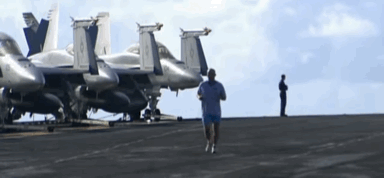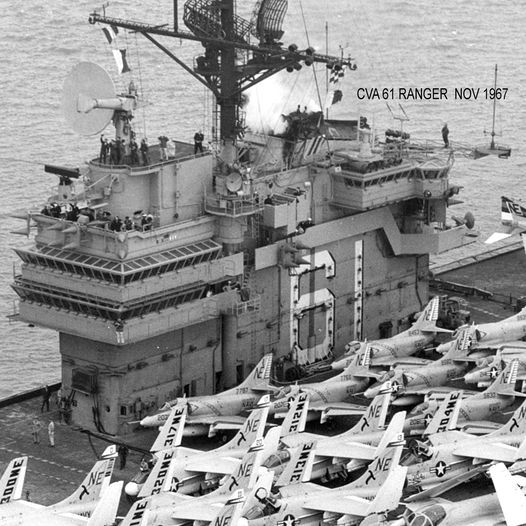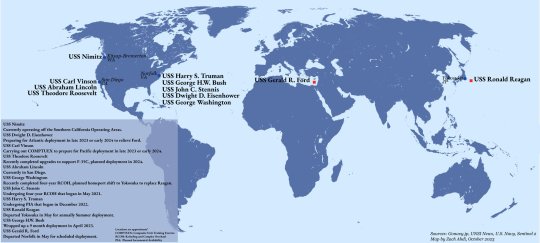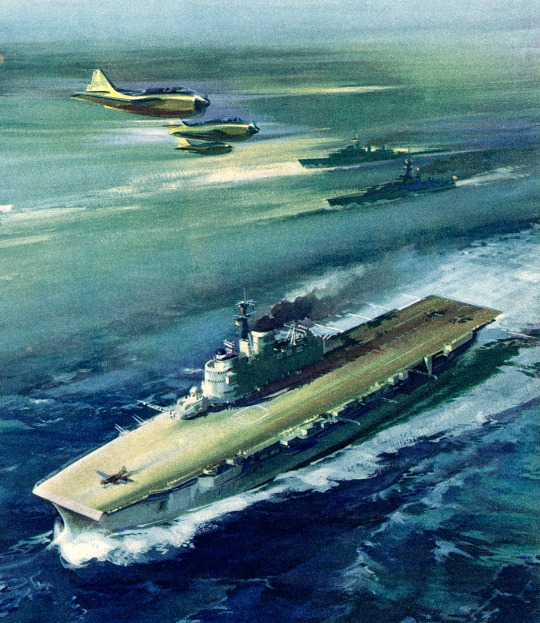#aircraft carriers
Text
THE AIRCRAFT CARRIER ROCK
Saw this video on tik tok and loved it so much. Of course I immediately knew it wasn’t an aircraft carrier, but because I’m me I did some digging on the effects of rough seas on aircraft carriers.
I remember seeing the pitching deck covered in an episode of Carrier, a PBS documentary covering life on an aircraft carrier that I refuse to shut up about. In a previous post I highlighted the effects of the pitching deck on pilots during nighttime carrier landings and just how TERRIFYING they are by adding a video from PBS Carrier episode Rite of Passage. During that episode a pilot had this to say:
Dude, all I know was I was in close and they’re like ‘a little power’ and I look down and saw the ******* back of the ship above me and I was like AHHHHHHH!!!!
But it’s dark and we can’t really see from that one video just how much it’s moving but like holy swear word tumblr won’t let me say!


And it’s crazy because to those below deck it looks a little different. Thanks to the sheer size and intricate design of aircraft carriers, there’s nothing more than a little sway to those on board.

I mean one wrong step and you’ll be hitting something hard I’m sure.

Of course there’s more to it than that. One person stated that you really just had to time when to go up ladders like when the ship falls off of a big wave you’ll kind of float up the ladder. He also had the following to say:
The North Atlantic is a bitch during winter. On the USS Kennedy 1976, in really bad weather, the seas were very rough. The ship turns into the waves, and goes up and down, no “rolling”. I watched 6 sailors, watching the TV in the berthing compartment, rise 4 feet into the air, and fall back to the Deck. no one even moved from the chairs. They were watching the recorded “Muppet Show”. A big hit back then!
Insane.
#aircraft carriers are wild man#aircraft carriers#top gun#top gun maverick#aviation#I like planes#and aircraft carriers#PBS Carrier#gifs#video#tik tok#video from PBS Carrier#f/a-18 hornet#f-16 fighting falcon#airplanes#research#information#navy#us navy#reference#just a little thing I wrote
135 notes
·
View notes
Text

ericfrench66 - Take-off on Aircraft-carrier
#aircraft carriers#navy#military#dancer#dancers#funny#planes#airplanes#gifs#take-off#ericfrench66#music and dance#boats & planes & trains#dance#jets
73 notes
·
View notes
Photo

This is how quickly USS Gerald R. Ford (CVN 78) reach the eastern Mediterranean.
93 notes
·
View notes
Text

Keeping Independence on the Move - 1956.
#vintage illustration#vintage advertising#shell oil#aircraft carriers#u.s. navy#u.s. military#u.s.s. independence#douglas skyhawk#douglas a-4 skyhawk#naval aviators
10 notes
·
View notes
Text


USS Yorktown (CV-5) - Heavily damaged after bomb and torpedo attacks during the battle of Midway. While under tow back to Pearl Harbor, she was torpedoed by the Japanese submarine I-168 and sunk on June 7, 1942.
USS Hornet (CV-8) - After being heavily damaged by bomb and torpedo attacks during the battle Santa Cruz Islands, and with news of an enemy surface force approaching, she was ordered to be scuttled. However, she did not sink until the enemy surface force arrived and torpedoed her. She sunk on October 27, 1942.
USS Enterprise (CV-6) - Fought in every major battle and campaign in the Pacfic theatre, from Pearl Harbor to Okinawa. She was the sole survivor out of the three sister ships in her class.
----------------------------------------
The first image is supposed to represent the rendezvous of the three Yorktown-class sister ships before the battle of Midway. The Yorktown in on the left, with MS 12 camouflage, Enterprise in the center, with MS 11 camouflage, and Hornet on the right with the modified MS 12 camouflage.
The second image represents the Enterprise, with MS 21 camouflage, at the Hudson river for the 1945 Navy Day Fleet Review.
#Art#Random Art#Ship-pones#My Little Pony#MLP#World War 2#WW2#History#USS Enterprise#USS Yorktown#USS Hornet#Aircraft Carriers#Yorktown-class#Poor sad Enterprise#She misses her sisters#Someone give her a hug
30 notes
·
View notes
Text

A-4 Skyhawks and A-7 Corsairs aboard USS Ranger
10 notes
·
View notes
Text
#my dude just boiled down the US military#America#aircraft carriers#us military#tiktok#usamerican#mine#<- not my video just my post
6 notes
·
View notes
Text

HMS Prince of Wales leads the fifteen ship formation on March 13 2024
2 notes
·
View notes
Text
The world of insects has invented aircraft carriers

[ ID: a snail bearing a wasp's nest on its shell ]
35 notes
·
View notes
Text
The Royal Navy: A History from the Earliest Times to the Death of Queen Victoria :: William Laird Clowes

View On WordPress
#1-8617-6010-8#aircraft carriers#amphibious warfare#ashantee#auxiliary warships#battleships#books by william laird clowes#british history#capital ships#china war#coastal forces#cruisers#destroyers#english navy#history british navy#history royal navy#history warships#indian mutiny#maritime history#minelayers#minesweepers#nautical history#naval history#navies#navy#navy history#patrol frigates#royal naval#submarines#torpedo-boats
2 notes
·
View notes
Text
Aircraft Carriers: Powerhouses of Modern Navies - A Deep Dive into Nimitz-Class, Queen Elizabeth-Class, and Global Carrier Fleets
Introduction to Aircraft Carriers
Aircraft carriers are monumental warships that serve as mobile airbases, enabling nations to project power far beyond their shores. They provide a platform for launching and recovering aircraft, which can perform a variety of roles, including air superiority, ground attack, anti-submarine warfare, and reconnaissance. These capabilities make aircraft carriers critical assets in modern naval strategy, allowing countries to exert influence over vast maritime regions, respond quickly to crises, and support global military operations.

Nimitz-Class Aircraft Carriers
The Nimitz-class carriers are a class of ten nuclear-powered aircraft carriers in service with the United States Navy. Named after Fleet Admiral Chester W. Nimitz, a key figure in the Pacific theater during World War II, these carriers have been the backbone of the U.S. Navy's carrier fleet since their introduction in the 1970s.
Design and Specifications: Nimitz-class carriers are among the largest warships in the world, each displacing around 100,000 tons. They measure approximately 1,092 feet in length and have a beam of 252 feet. Powered by two nuclear reactors, these carriers have a virtually unlimited range and can operate for over 20 years without refueling, providing sustained presence and flexibility.
Capabilities: The Nimitz-class carriers can accommodate about 90 aircraft, including F/A-18 Hornets, EA-18G Growlers, E-2C Hawkeyes, and MH-60R/S helicopters. The flight deck is equipped with four steam catapults, enabling rapid launch and recovery of aircraft. Advanced radar systems, electronic warfare capabilities, and missile defenses protect the carrier from various threats, ensuring it can operate effectively in contested environments.
Role and Deployment: Nimitz-class carriers have been deployed globally, participating in combat operations, humanitarian missions, and training exercises. They play a crucial role in projecting U.S. power, providing a credible deterrent, and supporting allies. Notable deployments include operations in the Persian Gulf, where they have supported combat missions in Iraq and Afghanistan, and disaster relief efforts in Southeast Asia.
Queen Elizabeth-Class Aircraft Carriers
The Queen Elizabeth-class carriers mark the Royal Navy's return to operating large aircraft carriers. This class comprises two ships: HMS Queen Elizabeth and HMS Prince of Wales. These carriers are the largest and most advanced warships ever built for the Royal Navy.
Design and Specifications: Each carrier displaces around 65,000 tons and measures 920 feet in length. They are conventionally powered, utilizing integrated electric propulsion systems. The design features twin islands, which improve command and control, and a ski-jump ramp for short take-off and vertical landing (STOVL) operations. The flight deck is capable of accommodating up to 40 aircraft.
Capabilities: The Queen Elizabeth-class carriers are designed primarily to operate the F-35B Lightning II, a fifth-generation multirole stealth fighter capable of STOVL operations. They can also deploy various helicopters, including the Merlin for anti-submarine warfare and airborne early warning, as well as Chinooks for troop transport. These carriers are equipped with advanced radar and self-defense systems, ensuring they can operate in high-threat environments.
Role and Deployment: These carriers enhance the UK's ability to project power globally. HMS Queen Elizabeth has already completed her maiden operational deployment, integrating with NATO allies and participating in multinational exercises in the Mediterranean, Indian Ocean, and the Pacific. The Queen Elizabeth-class carriers are expected to be central to the UK's defense strategy, providing rapid response capabilities and supporting international security efforts.
Aircraft Carriers by Country
Aircraft carriers are a potent symbol of naval power, and several nations operate or are developing carriers to bolster their strategic capabilities.
United States: The U.S. Navy operates 11 aircraft carriers, including the Nimitz-class and the new Ford-class, which will eventually replace the older Nimitz-class ships. These carriers form the core of the U.S. Navy's blue-water capabilities, ensuring global reach and influence. The Ford-class carriers introduce advanced technologies, including electromagnetic catapults and improved nuclear reactors, enhancing operational efficiency and combat capability.
United Kingdom: The Royal Navy operates two Queen Elizabeth-class carriers, which restore its ability to conduct carrier strike operations. These carriers are pivotal to the UK's defense strategy, enabling rapid response to crises and supporting global security efforts. Their integration with F-35B aircraft and advanced support systems enhances their operational versatility and effectiveness.
France: The French Navy operates the Charles de Gaulle, a nuclear-powered aircraft carrier. Commissioned in 2001, it supports a range of operations, from air superiority to anti-submarine warfare. The Charles de Gaulle has been deployed in various missions, including combat operations in the Middle East and humanitarian relief efforts. France plans to develop a new-generation carrier to replace it by the late 2030s, ensuring continued carrier capability.
China: China has been rapidly expanding its carrier capabilities, with two carriers currently in service: Liaoning (a refitted Soviet-era carrier) and Shandong (an indigenous design). A third, more advanced carrier, the Type 003, is under construction. These carriers signify China's growing naval ambitions and its desire to project power in the Asia-Pacific region. They support China's strategy of securing its maritime interests and extending its influence.
India: The Indian Navy operates INS Vikramaditya, a modified Kiev-class carrier, and is building its first indigenous carrier, INS Vikrant. These carriers are crucial for India's strategic presence in the Indian Ocean and beyond. They enhance India's ability to project power, support regional stability, and respond to maritime threats.
Russia: Russia's carrier capability is currently limited to the Admiral Kuznetsov, a vessel that has faced numerous technical challenges and is undergoing a lengthy refit. While Russia has plans to develop new carriers, financial and technical hurdles have delayed progress. Despite these challenges, Russia continues to prioritize carrier development as part of its broader naval modernization efforts.
Other Countries: Several other nations, including Italy, Spain, and Japan, operate smaller carriers or amphibious assault ships capable of launching fixed-wing aircraft. These platforms enhance their regional capabilities and support international operations. For instance, Japan's Izumo-class ships are being modified to operate F-35B aircraft, reflecting a strategic shift towards increased carrier capability.
Conclusion

Aircraft carriers by country remain a central component of modern naval strategy, offering unmatched versatility and power projection. The Nimitz-class and Queen Elizabeth-class carriers exemplify the pinnacle of carrier design and capability, each serving their respective nations' strategic needs. As more countries seek to develop or expand their carrier capabilities, the global naval landscape continues to evolve, underscoring the enduring importance of these formidable vessels. Whether through deterrence, humanitarian aid, or combat operations, aircraft carriers will continue to shape the future of naval warfare.
0 notes
Text
#I hate posting tik Toks but they’re too good not to sometimes#this happened in 1986 so I couldn’t not to post it#aircraft carriers#top gun#helicopters#helos#helo jet rivalry#all in good fun of course#tik tok#video
31 notes
·
View notes
Text

FROM : emmrekz
#emmrekz#planes#airplanes#military#vintage#gifs#black & white#bw#boats & planes & trains#jets#others & vintage#news#accidents & news & various infos#aircraft carriers
28 notes
·
View notes
Photo

Where are the US aircraft carriers?
The locations are pretty approximate and dated to last week for some of the carriers and a few days ago for others.
by ThrustWR
47 notes
·
View notes
Text

The Royal Navy aircraft carrier, HMS Illustrious.
#vintage illustration#hms illustrious#the royal navy#aircraft carriers#war ships#carrier groups#united kingdom#great britain
7 notes
·
View notes
Text
#business forecast#(APC)#aircraft carriers#cargo ships#defense ships#fighter jet#infantry fighting vehicles#Main battle tank#oil carriers#patrol ships#special mission aircraft#transport aircraft#unmanned platforms#defense simulation market#defense simulation market report#defense simulation market growth#defense simulation market size#defense simulation market analysis#defense simulation market trends#defense simulation market forecast
0 notes